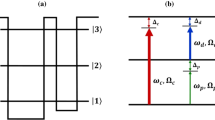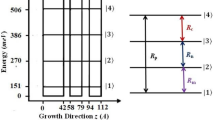Abstract
A four level ladder scheme is employed for the realization of slow light large Kerr nonlinear indices in an asymmetric semiconductor three-coupled-quantum-well (TCQW) structure based on intersubband transitions. It is shown that a giant Kerr nonlinearity accompanied with negligible loss can be achieved by properly tuning the intensity of the control fields. A dressed state analysis is given to explain the origin of such a transparency based on slow light enhanced Kerr nonlinearity in this solid medium. In addition, we show that the three-photon detuning plays the important role in enhancing the third-order nonlinearity of the TCQW medium, and may provide new possibilities for technological applications in nonlinear optics and optical switching.
Similar content being viewed by others
References
S.E. Harris, “Electromagnetically Induced Transparency,” Phys. Today. 50(7), 36 (1997) [DOI: doi.org/10.1063/1.881806].
Ying Wu and Xiaoxue Yang, “Electromagnetically Induced Transparency in V -, Λ-, and Cascade- Type Schemes Beyond Steady-State Analysis,” Phys. Rev. A. 71(5), 053806 (2005) [DOI: doi.org/10.1103/ PhysRevA.71.053806].
Zhiping Wang and Benli Yu, “High Refractive Index without Absorption in a Rare-Earth-Ion-Doped Optical Fiber,” Appl. Phys. A. 109, 725 (2012).
J. Mompart and R. Corbalán, “Lasing without Inversion,” J. Opt. B: Quantum Semiclass. Opt. 2, R7 (2000).
H.R. Hamedi, “Transient Absorption and Lasing without Inversion in an Artificial Molecule via Josephson Coupling Energy,” Laser Phys. Lett. 12, 035201 (2015).
L.V. Hau, S.E. Harris, Z. Dutton, and C.H. Behroozi, “Light Speed Reduction to 17 Metres per Second in an Ultracold Atomic Gas,” Nature. 397, 594 (1999).
M.M. Kash, V.A. Sautenkov, A.S. Zibrov, L. Hollberg, G.R. Welch, M.D. Lukin, Y. Rostovtsev, E.S. Fry, and M.O. Scully, “Ultraslow Group Velocity and Enhanced Nonlinear Optical Effects in a Coherently Driven Hot Atomic Gas,” Phys. Rev. Lett. 82(26), 5229 (1999) [DOI: doi.org/10.1103/PhysRevLett.82.5229].
S.M. Ma, H. Xu, and B.S. Ham, “Electromagnetically- Induced Transparency and Slow Light in GaAs/AlGaAs Multiple Quantum Wells in a Transient Regime,” Opt. Exp. 17, 14902 (2009).
Ying Wu, “Two-Color Ultraslow Optical Solitons via Four-Wave Mixing in Cold-Atom Media,” Phys. Rev. A. 71(5), 053820 (2005) [DOI: doi.org/10.1103/ PhysRevA.71.053820].
Ying Wu and L. Deng, “Ultraslow Optical Solitons in a Cold Four-State Medium,” Phys. Rev. Lett. 93(14), 143904 (2004) [DOI: doi.org/10.1103/Phys-RevLett.93.143904].
L. Li and G.X. Huang, “Slow-Light Solitons in Three-Level Atomic Systems Modified by a Microwave Field,” Europ. Phys. J. D. 58, 339 (2010).
Wen-Xing Yang and Ray-Kuang Lee, “Slow Optical Solitons via Intersubband Transitions in a Semiconductor Quantum Well,” Europhys. Lett. 83, 14002 (2008).
J.-H. Li, X.-Y. Lü, J.-M. Luo, and Q.-J. Huang, “Optical Bistability and Multistability via Atomic Coherence in an N-Type Atomic Medium,” Phys. Rev. A. 74(3), 035801 (2006) [DOI: doi.org/10.1103/PhysRevA.74.035801].
Z. Wang and B. Yu, “Optical Bistability and Multistability via Dual Electromagnetically Induced TransparencyWindows,” J. Lumin. 132, 2452 (2012).
Shili Li, Qiang Ge, Zhiping Wang, J.C. Martín, and Benli Yu, “Optical Bistability via an External Control Field in All-Fiber Ring Cavity,” Sci. Rep. 7, 8992 (2017).
D. Zhang, J. Li, C. Ding, and X. Yang, “Control of Optical Bistability via an Elliptically Polarized Light in a Four-Level Tripod Atomic System,” Phys. Scripta. 85, 5401 (2012).
M. Sahrai, H.R. Hamedi, and M. Memarzadeh, “Kerr Nonlinearity and Optical Multi-Stability in a Four- Level Y-Type Atomic System,” J. Mod. Opt. 59, 980 (2012).
Zhen Wang, Ai-Xi Chen, Yanfeng Bai, Wen-Xing Yang, and Ray-Kuang Lee, “Coherent Control of Optical Bistability in an Open Λ-Type Three-Level Atomic System,” J. Opt. Soc. Am. B. 29, 2891 (2012).
Jia-Hua Li, “Controllable Optical Bistability in a Four-Subband Semiconductor Quantum Well System,” Phys. Rev. B. 75(15), 155329 (2007) [DOI: doi.org/10.1103/PhysRevB.75.155329].
S.H. Asadpour, H.R. Hamedi, and H.R. Soleimani, “Optical Bistability and Multistability in an Open Ladder-Type Atomic System,” J. Mod. Opt. 60, 659 (2013).
Y. Wu and X. Yang, “Giant Kerr Nonlinearities and Solitons in a Crystal of Molecular Magnets,” Appl. Phys. Lett. 91(9), 094104 (2007).
Xiang-an Yan, Li-qiang Wang, Bao-yin Yin, Wenjuan Jiang, Huai-bin Zheng, Jian-ping Song, and Yan-peng Zhang, “Effect of Spontaneously Generated Coherence on Kerr Nonlinearity in a Four-Level Atomic System,” Phys. Lett. A. 372(42), 6456 (2008) [DOI: doi.org/10.1016/j.physleta.2008.08.056].
H.R. Hamedi and M.R. Mehmannavaz, “Switching Feature of EIT-Based Slow Light Giant Phase- Sensitive Kerr Nonlinearity in a Semiconductor QuantumWell,” Phys. E. 66, 309 (2015).
Wen-juan Jiang, Xiang’an Yan, Jian-ping Song, Huai-bin Zheng, Chuanxing Wu, Bao-yin Yin, and Yanpeng Zhanga, “Enhancement of Kerr Nonlinearity via Spontaneously Generated Coherence in a Four-Level N-Type Atomic System,” Opt. Commun. 282(1), 101 (2009) [DOI: doi.org/10.1016/ j.optcom.2008.08.054].
S.H. Asadpour and H.R. Hamedi, “Giant Kerr Nonlinearity in an n-Doped Semiconductor Quantum Well,” Opt. Quantum Electron. 45, 11 (2013).
H. Wang, D. Goorskey, and M. Xiao, “Dependence of Enhanced Kerr Nonlinearity on Coupling Power in a Three-Level Atomic System,” Opt. Lett. 27, 258 (2002).
Sun Hui, Niu Yue-Ping, and Gong Shang-Qing, “Enhancement of Kerr Nonlinearity with Vanishing Absorption in a Tripod Scheme,” Chin. Phys. 16, 429 (2007).
Yueping Niu and Shangqing Gong, “Enhancing Kerr Nonlinearity via Spontaneously Generated Coherence,” Phys. Rev. A. 73(5), 053811 (2006) [DOI: doi.org/10.1103/PhysRevA.73.053811].
Wen-Xing Yang, Jing-Min Hou, and Ray-Kuang Lee, “Ultraslow Bright and Dark Solitons in Semiconductor Quantum Wells,” Phys. Rev. A. 77(3), 033838 (2008) [DOI: doi.org/10.1103/ PhysRevA.77.033838].
Wen-Xing Yang, Jing-Min Hou, YuanYao Lin, and Ray-Kuang Lee, “Detuning Management of Optical Solitons in Coupled Quantum Wells,” Phys. Rev. A. 79(3), 033825 (2009) [DOI: doi.org/10.1103/Phys-RevA.79.033825].
A. Joshi, “Phase-Dependent Electromagnetically Induced Transparency and Its Dispersion Properties in a Four-Level Quantum Well System,” Phys. Rev. B. 79(11), 115315 (2009) [DOI: doi.org/10.1103/Phys-RevB.79.115315].
A. Imamoglu and R.J. Ram, “Semiconductor Lasers without Population Inversion,” Opt. Lett. 19, 1744 (1994).
D.E. Nikonov, A. Imamoğlu, and M.O. Scully, “Fano Interference of Collective Excitations in Semiconductor Quantum Wells and Lasing without Inversion,” Phys. Rev. B. 59(19), 12212 (1999) [DOI: doi.org/10.1103/PhysRevB.59.12212].
Hui Sun, Shangqing Gong, Yueping Niu, Shiqi Jin, Ruxin Li, and Zhizhan Xu, “Enhancing Kerr Nonlinearity in an Asymmetric Double Quantum Well via Fano Interference,” Phys. Rev. B. 74(15), 155314 (2006) [DOI: doi.org/10.1103/ PhysRevB.74.155314].
Zhiping Wang and Hongyi Fan, “Phase-Dependent Optical Bistability and Multistability in a Semiconductor Quantum Well System,” J. Lumin. 130, 2084 (2010).
Wei Yan, Tao Wang, XiaoMing Li, and YaJuan Jin, “Tunable Amplification and Absorption Properties in Double-Λ System of GaAs/AlGaAs Multiple QuantumWells,” Chin. Sci. Bull. 58, 53 (2013).
E. Paspalakis, M. Tsaousidou, and A.F. Terzis, “Coherent Manipulation of a Strongly Driven Semiconductor Quantum Well,” Phys. Rev. B. 73(12), 125344 (2006) [DOI: doi.org/10.1103/ PhysRevB.73.125344].
Yandong Peng, Yueping Niu, Yihong Qi, Haifeng Yao, and Shangqing Gong, “Optical Precursors with Tunneling-Induced Transparency in Asymmetric QuantumWells,” Phys. Rev. A. 83(1), 013812 (2011) [DOI: doi.org/10.1103/PhysRevA.83.013812].
C. Sirtori, F. Capasso, D.L. Sivco, and A.Y. Cho, “Giant, Triply Resonant, Third-Order Nonlinear Susceptibility χ(3) 3ω in Coupled Quantum Wells,” Phys. Rev. Lett. 68(7), 1010 (1992) [DOI: doi.org/10.1103/PhysRevLett.68.1010].
C. Sirtori, F. Capasso, J. Faist, and S. Scandolo, “Nonparabolicity and a Sum Rule Associated with Bound-to-Bound and Bound-to-Continuum Intersubband Transitions in Quantum Wells,” Phys. Rev. B. 50(12), 8663 (1994) [DOI: doi.org/10.1103/ PhysRevB.50.8663].
Xiangying Hao, Jiahua Li, and Xiaoxue Yang, “Mid- Infrared EfficientGeneration by Resonant Four-Wave Mixing in a Three-Coupled-Quantum-Well Nanostructure,” Opt. Commun. 282, 3339 (2009).
Deng Li, “Steady-State Analysis of Three-Photon Absorption Spectra via Density-Matrix Method in a Three Coupled-Quantum-Well Nanostructure,” Chin. Phys. B. 19, 054205 (2010).
M.D. Frogley, J.F. Dynes, M. Beck, J. Faist, and C.C. Phillips, “Gain without Inversion in Semiconductor Nanostructures,” Nature Mater. 5, 175 (2006).
J.F. Dynes, M.D. Frogley, M. Beck, J. Faist, and C.C. Phillips, “AC Stark Splitting and Quantum Interference with Intersubband Transitions in Quantum Wells,” Phys. Rev. Lett. 94, 157403 (2005).
J. Faist, F. Capasso, C. Sirtori, K.W. West, and L.N. Pfeiffer, “Controlling the Sign of Quantum Interference by Tunnelling from Quantum Wells,” Nature. 390, 589 (1997).
G.B. Serapiglia, E. Paspalakis, C. Sirtori, K.L. Vodopyanov, and C.C. Phillips, “Laser-Induced Quantum Coherence in a Semiconductor Quantum Well,” Phys. Rev. Lett. 84(5), 1019 (2000) [DOI: doi.org/ 10.1103/PhysRevLett.84.1019].
C.-R. Lee, Y.-C. Li, F.K. Men, C.-H. Paoa, Y.-C. Tsai, and J.-F. Wang, “Model for an Inversionless Two- Color Laser,” Appl. Phys. Lett. 86, 201112 (2005).
J.F. Dynes, M.D. Frogley, J. Rodger, and C.C. Phillips, “Optically Mediated Coherent Population Trapping in Asymmetric Semiconductor QuantumWells,” Phys. Rev. B. 72(8), 085323 (2005) [DOI: doi.org/ 10.1103/PhysRevB.72.085323].
Jia-Hua Li, “Coherent Control of Optical Bistability in Tunnel-Coupled Double Quantum Wells,” Opt. Commun. 274, 366 (2007).
Hui Sun, Yueping Niu, Ruxin Li, Shiqi Jin, and Shangqing Gong, “Tunneling-Induced Large Cross- PhaseModulation in an Asymmetric QuantumWell,” Opt. Lett. 32(17), 2475 (2007).
Ying Wu and Xiaoxue Yang, “Highly Efficient Four- Wave Mixing in Double-Λ System in Ultraslow Propagation Regime,” Phys. Rev. A. 70(5), 053818 (2004) [DOI: doi.org/10.1103/PhysRevA.70.053818].
Ying Wu, J. Saldana, and Yifu Zhu, “Large Enhancement of Four-Wave Mixing by Suppression of Photon Absorption from Electromagnetically Induced Transparency,” Phys. Rev. A. 67(1), 013811 (2003) [DOI: doi.org/10.1103/PhysRevA.67.013811].
H.R. Hamedi, A. Khaledi-Nasab, A. Raheli, and M. Sahrai, “Coherent Control of Optical Bistability and Multistability via Double Dark Resonances (DDRs),” Opt. Commun. 312, 117 (2014) [DOI: doi.org/10.1016/j.optcom.2013.08.081].
H.R. Hamedi and S.H. Asadpour, “Realization of Optical Bistability and Multistability in Landau- Quantized Graphene,” J. Appl. Phys. 117, 183101 (2015) [DOI: doi.org/10.1063/1.4919893].
Author information
Authors and Affiliations
Corresponding author
About this article
Cite this article
Raheli, A. Giant Kerr Nonlinearity for Three-Coupled-Quantum-Well Nanostructures. Phys. Wave Phen. 26, 182–190 (2018). https://doi.org/10.3103/S1541308X18030020
Received:
Published:
Issue Date:
DOI: https://doi.org/10.3103/S1541308X18030020




